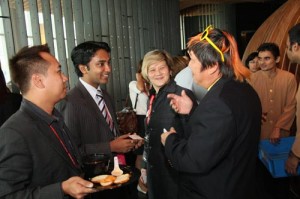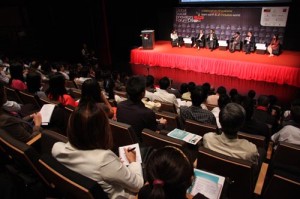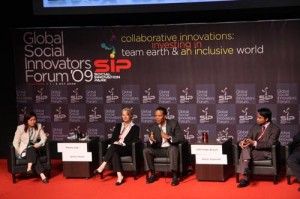Global Social Innovators Forum 2009 — which took place 1 to 3 October at the suitably futuristic venue of Fusionopolis along South Buona Vista Road in Singapore — proved to be a hotbed of ideas and newly formed manifestos for “Team Earth” and “an all-inclusive world”.
World-famous thinkers, economists, retailers, movers and shakers came together to put their weight behind new ways to right the ills in the world today, from greening the earth and restoring balance, to bridging gaps in society. “Collaborative Innovations” was the title of this year’s conference, alluding to the coming together of all the stakeholders: businesses, policy makers, media and the everyman. Big-name guests included John Hope Bryant, Founder and CEO of Operation HOPE; S Rob Walton, CEO of WalMart; Suhas Gopinath, CEO of Globals Inc and the youngest CEO in the world and Peter Seligmann, Chairman of Conservation International. From Singapore, members of Parliament showed their support: Senior Minister of State (Ministry of Foreign Affairs) Zainal Abidin; Minister for Community Development Youth and Sports, Dr Vivian Balakrishnan; Minister of Foreign Affairs George Yeo, and Minister of State Mrs Yu-Foo Yee Shoon.
The conference was chaired by the tireless Penny Low, Member of Parliament and founder of Social Innovation Park. What sparked great interest was the participation of Alvin Toffler, futurist and author of the influential tomes Future Shock and The Third Wave. Toffler took part in the opening plenary session by live webcast from the US, and quickly set the tone for the conference’s nine key sessions and 11 breakout workshops.
“Social innovators may not be making a lot of money yet, but they are the new heroes,” he declared. Toffler’s prediction of the shake-ups that would take place as the world progresses from the industrial age into a knowledge-based economy has in part already come to pass. The current crisis can’t be solved with industrial-age methods — it is in fact an opportunity for the world to find a new way to live, trade, build and be accountable. Recognizing that increased religiosity in the world is affecting the quest for an “all-inclusive world”, Toffler also made a bid for the religious to “kiss science” — or be left behind. With that, the conference was launched, showcasing the people who are already living this new way, and paving the path for the rest of the world to follow, which promises to reap great benefits for all, in a series of win-win collaborations.
Great examples of these include Walmart’s commitment to buy from sustainable suppliers, promoting renewable energy and making its company “zero waste”; Pepsico’s ingenious creation of a social music event in China to attract Chinese youth to the importance of protecting the Yellow River; and Singapore’s leadership in geographical greening efforts, which is being used as a model in other first-world cities.
 |
| PHOTOS: Elvis Chiu |
One highlight of the conference was the SIP Awards and Gala dinner, which was held on the first evening at the Marina Barrage (perfectly suitable because it is one of the greenest, low-energy places in Singapore). S Rob Walton was presented the SIP Distinguished Fellow Award, for WalMart’s continued efforts to do business with a green conscience.
SIP Fellow Awards were given out to outstanding social innovators from across the world: From the USA, John Hope Bryant, founder and CEO of Operation HOPE, America’s first non-profit social investment banking organization, and Peter Seligmann, founder of Conservation International. From China, Calvin Chin, co-founder and CEO of Qifang, a web service that allows Chinese tertiary students to find lenders and donors to pay for their education. From India, Suhas Gopinath, the world’s youngest entrepreneur when he was 16, CEO of Globals Inc, a web 2.0 solutions company with clients around the world. And from Singapore, Melissa Aratani Kwee, serial social entrepreneur and founder of Project Access and Beautiful People, and Dr Ting Choon Meng, a serial inventor of medical devices and an author.
Workshops slotted between key sessions gave delegates the opportunity to spar on fresh ideas and ask questions of the speakers. Lively discussions ensued on topics such as the role of the media in social innovation, and how technology can be used to alleviate poverty. It was an unusual conference in spirit: it seemed rare to experience a gathering of individuals who were as — or more — eager to share and to help than to gain something for themselves. GSIF was effective in shedding light on the tangled web the world has woven, and the fact that every person at that conference has a real responsibility and authority to do something about the world we live in, and to quote Michael Jackson) make it a better place. Delegates left inspired, with new insights, fresh ideas, and a palpable excitement about what the next 12 months will bring before all are gathered here in Singapore again, very likely with good reports.
For more information about GSIF 2009, visit www.socialinnovatorsforum.org.
To find out more about what Social Innovation Park does, go to www.socialinnovationpark.org.
MORE ON GSIF:
• John Hope Bryant article


